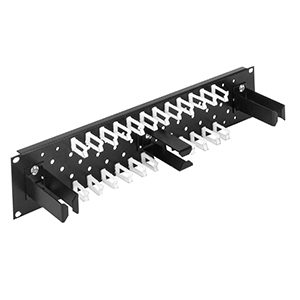by Ravi Jain, Bud Industries Inc.
The design of enclosures to house networking servers, telecommunications equipment and components should be guided by a number of factors. For server racks, Servers, in particular, generate a great deal of heat, and an enclosure must be capable of dissipating the heat to ensure that the components deliver their expected life. For telecom distribution racks, cable management is most important.
Aside from heat dissipation, enclosures for networking systems should provide for easy access to the interior, facilitate assembly and mounting, and provide for wiring management. Here are some practical guidelines for selecting enclosures for networking equipment.
1. Server racks should have proper ventilation.

Bud’s Professional Series Server Racks are well ventilated.
As noted, servers can generate a lot of heat, and the more servers used, the more heat generated. While networks consisting of just a few servers can be housed in standard cabinets and enclosures, systems with multiple or densely packed servers should be housed in special server racks. Such racks include ventilation slots on the front, sides, rear and top to promote maximum airflow around components.
To increase airflow, the enclosure should incorporate fans and blowers at strategic locations. Fan tray assemblies can be mounted directly below critical components to direct airflow against local hot spots and to prevent hot air from being trapped within the enclosure.
2. Choose networking enclosures based on your environment.
Local conditions may dictate the use of specially designed racks and enclosures. For example, seismic racks should be specified for earthquake prone areas. These racks conform to Telcordia (formerly Bellcore) #GR-63-CORE, Issue 1 and feature reinforced construction to provide seismic protection. In a factory, NEMA enclosures should be used to protect components from dust, moisture, airborne contaminants such as oil mist and metal shavings, and washdown. NEMA cabinets have door seals to prevent dust, water and other contaminants entry. However, care must be taken to specify the correct NEMA designation. For example, many users specify NEMA 12 enclosures thinking they provide more environmental protection than NEMA 4. In fact, the opposite is true.
For office settings, open racks are often sufficient. These racks are typically located in a separate room, and do not need protection from water or dust. The open rack configuration provides maximum airflow around components.
3. Network racks should have easy access to the interior.
Despite all best efforts, components do occasionally fail. In addition, networks often must be reconfigured to provide more capacity. Thus, the enclosure should be designed for easy access to the interior by incorporating removable doors, side panels and backs.
4. Properly assemble and mount your server rack.
The most time-consuming part of building a rack assembly is mounting the components. Some vendors ease this task and speed assembly by supplying mounting racks with pre-tapped holes. In addition, some servers require special adapters and mounting rails, so care must be taken to ensure that the servers fit the racks being considered.
5. Use cable management accessories to organize cables in your network enclosure.

Organize cables with a cable management panel.
Unorganized cables can significantly increase the time required to assemble equipment and make repairs. Therefore, the enclosure should provide sufficient space for routing of cable, and the vendor should have cable management accessories available. These parts not only simplify routing and repair, but also provide a neat appearance.
6. Pre-assembled racks for servers can be more cost-effective than standard enclosures.
Most vendors offer these modifications at little extra cost. Pre-assembly at the factory can provide a more cost-effective solution than standard enclosures.
7. Choose a vendor that can offer design support for custom server racks.
Work with a vendor who will accept your drawings and recommend cost-saving alternatives. In addition, choose vendors that offer a broad range of enclosure types and sizes, and accessories, so you can more exactly match your needs.
See more Bud Industries press releases.



